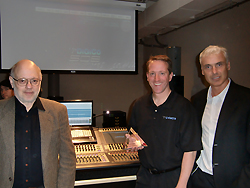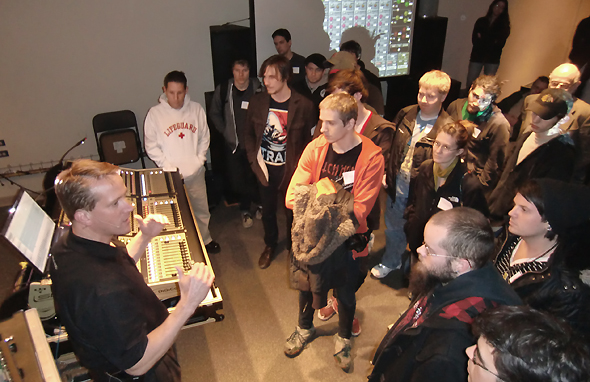Columbia College in Chicago, the largest and most diverse private arts and media college in the U.S., recently installed a DiGiCo SD8 digital console in the school’s main lab/classrtoom.
Jack Alexander, Director of the Live Sound Program and Associate Professor at Columbia College (and a veteran audio industry professional) had been exploring options to swap out an existing analog console. An analog diehard, he was unmoved to pull the trigger on a digital console until the release of DiGiCo’s SD8.
Once installed, Alexander has found that the SD8’s sound quality, the infinite processing, the “Overdrive” software update functionality, and the price point, were designed “with engineers in mind, rather than computer geeks… making it more intuitive, in use, than the competition.”
“It is no secret that I have had reservations about digital consoles from the beginning,” he states, “principally the issues of sound quality and the clunky, excessively layered interfaces featured in first and second generation digital desks.
“I was at the launch of the original DiGiCo D5 at AES in 2004 and was blown away at the sound and accessibility. It was out of our price range, which left certain other options more financially approachable, but compromised with the two problems noted above. The SD8 provided the known DiGiCo advantages at a price that fit our budget—and it’s still the real deal.”
Alexander says other key personnel, including Audio Arts and Acoustics Chairman Dr. Pantelis Vassilakis and Operations Manager,Ron Elling, were instrumental in the decision, along with DiGiCo’s Matt Larson. “They did the heavy lifting on the deal and were its enablers. I got everyone talking and they took it from there,” Alexander adds.
The SD8 rests on an EZ-tilt sited on a riser in room LL11, a 1,400-square-foot lab/classroom located in the lower level of one of the CCC’s campus buildings. The classroom features a state of the art, high output 7.3 multichannel live/playback system, multiple projection screens, and a large collection of sound reinforcement paraphernalia, including analog and digital processors and loudspeaker management (the speakers are controlled via a network of nine XTA units), as well as a fully stocked microphone cabinet.
During the same class period, the curriculum might jump from mixing a live band with 20+ inputs, to playback of a concert Blu-ray disc in 7.3, followed by an SACD rendered in two-channel analog.
“Live bands are hitting the control surface through mics/DI’s and Red Book CD/SACD/hard drive-sourced music files/Blu-ray/standard DVD are all used at various times for classes. The SD8’s stage box greatly simplifies these adjustments, but it is the number of ins and outs provided in the SD8 and the storage and recall capability of the desk that have changed the world for us,” Alexander says.
“Outputs are used in various configurations, from mono up through 7.3, and we also use the desk for stage monitor classes. The flexibility of the output busses is a major feature for us. At first, I viewed the 1/3-octave equalizers provided in the software package as hardly more than toys. They are now the only ‘thirds’ I use in class and our Klark Tekniks have been relegated to storage—which do not compare in sound quality or headroom and are not part of the integrated software/hardware package the SD8 provides.
“The integration and data storage options are a major improvement over our previous analog situation. The layout, unlike some of the SD8’s competition, enables rather than impedes the work of the operator.”
“Along with everything previously noted,” Alexander continues, “the big Kahuna, as they say, is the fact that we can grab the video output of the touch screen and put it up real-time on projection. In the past, we’ve had people huddled around consoles or thirds, trying to make associations between what they were seeing (barely) and what was happening aurally with the sound system.
“Now as many as 60 students can watch the adjustments real-time as they happen. This is an enormous change that wasn’t even factored into the purchase decision. I would encourage any institution involved in the teaching of audio to consider this enormous advantage when making console purchase decisions.”





















